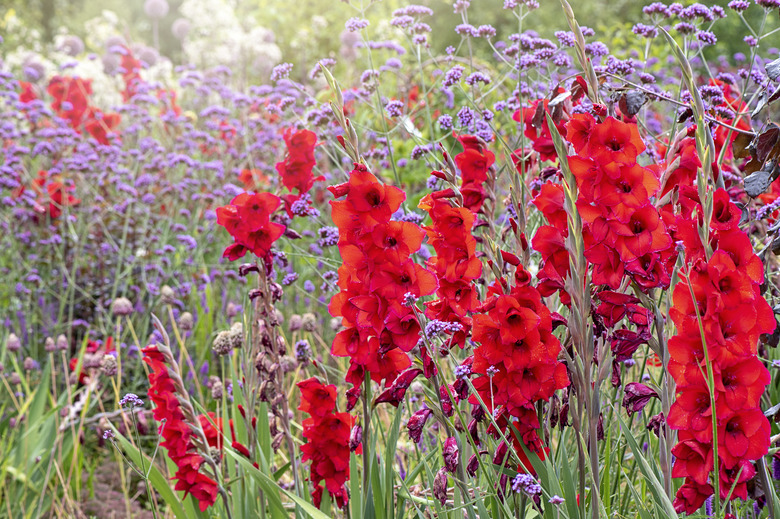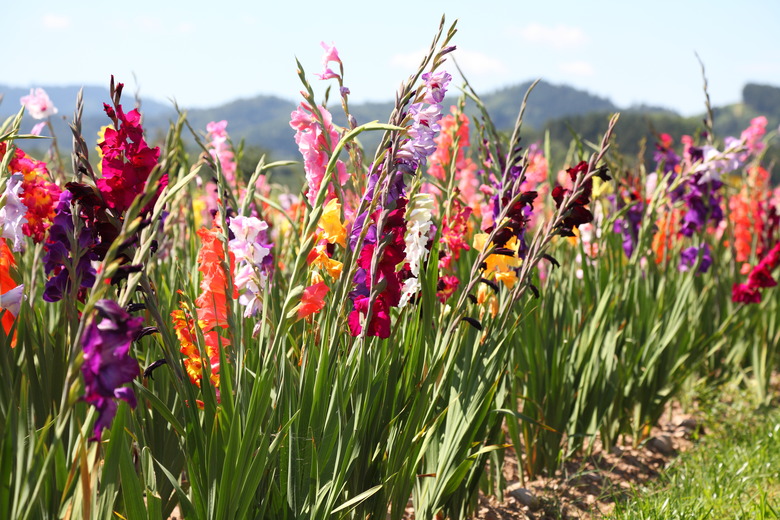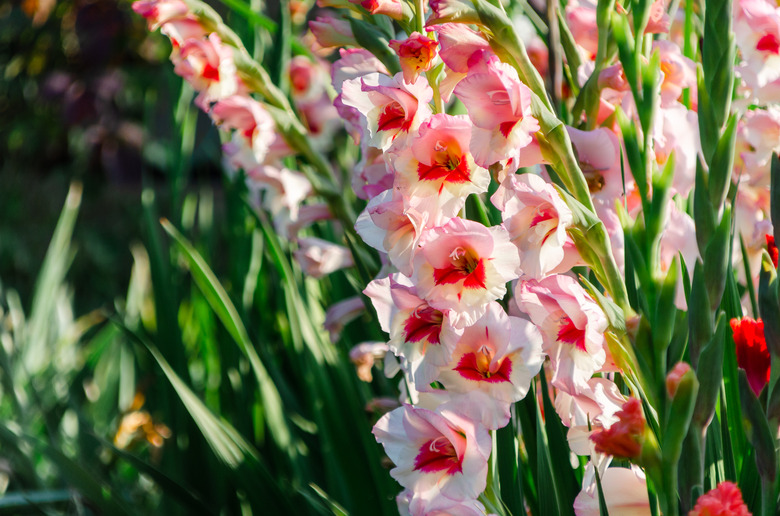How To Grow Gladiolus
- Best uses for gladiolus
- How to grow gladiolus
- In what zone does gladiolus grow best?
- When should you plant gladiolus?
- Soil, sunlight and water recommendations for gladiolus
- How to propagate gladiolus
- How to winterize gladiolus
- How to harvest gladiolus
- Common pests and other problems for gladiolus
- Common diseases for gladiolus
Gladiolus (Gladiolus spp.) is a tall, flowering perennial plant with long, narrow leaves and colorful flower spikes that can have anywhere from one to 20 blooms. The flowers come in a rainbow of colors, including purple, pink, red, orange, yellow, blue and even green. Gladiolus plants, often nicknamed "glads," derive their name from the Latin word "gladius," which means "sword," and that is what their long, thin leaves resemble. This is also why gladioli are sometimes called "sword lilies," even though they are not "true" lilies in the Lilium genus.
The plants grow a single flower stalk between midsummer and fall, so it is a good idea to stagger plantings to ensure blooms throughout the flowering season, creating a dazzling show for your garden for the end of the growing season.
The plants only reach about 1 foot wide, but they can grow anywhere between 1 and 5 feet tall. Their impressive height and colorful blossoms make these plants an eye-catching addition to any bouquet and a great choice to fill in the middle or rear of an annual flower garden.
Best Uses for Gladiolus
Best Uses for Gladiolus
Grown for only their beauty, gladiolus are purely ornamental in your garden. Because the flower spikes can reach such tall heights, most varieties of gladiolus need to be staked, caged or otherwise supported so they do not flop over or become curved in wind or rain. Some dwarf varieties do not require staking, though, and you may also be able to avoid staking in tall species by planting them beside tall, bushy plants.
Depending on species and cultivar, gladioli can grow back year after year with minimal effort if you live in USDA hardiness zones 4 through 10, although many types will need to be grown as annuals.
Gladioli are grouped based on their flower size, with classes ranging from miniature blooms under 3 inches in diameter to giant blossoms over 5 inches across. With around 260 varieties of gladioli with flowers in all shapes, sizes and colors as well as plant heights that vary from 2 to 5 feet, there's certain to be a type that appeals to your tastes.
How to Grow Gladiolus
How to Grow Gladiolus
- Common Name: Gladiolus
- Botanical Name: Gladiolus spp.
- When to Plant: Spring through midsummer
- USDA Zones: 4-10, depending on species and cultivar
- Sun Exposure: Full
sun - Soil Type: Well-draining,
fertile soil - When it's in Trouble: Streaked and discolored leaves or flowers;
small colored spots on the plants; white dots on foliage; webbing or
sticky residue on leaves; yellowing foliage; green and deformed petals - When it's Thriving: Long, straight green leaves; tall flower spikes bearing blooms in
vivid colors; plump, firm corms
Starting Gladiolus From Corms
When you decide to plant gladiolus flowers, pay attention to the quality of the corms, or bulb-like underground plant stems. Only buy large, firm and plump corms. The size will vary based on the species, but they should always be a minimum of 1 1/4 inches in diameter.
Gladiolus plants can be started at any time in spring, as early as two weeks before the last frost date in your area. Before digging, do some research for the right planting depth and spacing for your gladiolus species. Larger corms will generally need to be buried 4 to 6 inches deep, medium-sized corms should be planted 3 to 4 inches deep and small corms will only need to be buried 2 to 3 inches deep. Spacing should be 5 to 10 inches apart and should vary based on corm size and your intended use of the gladioli.
For best results when growing cut flowers, plant corms in rows to make harvesting easier. To create more visual appeal in an annual flower bed, plant gladioli in groups of seven or more. Be sure to grow at least 10 gladiolus plants at once to create a nice display.
Prior to planting, amend your soil with 2 to 4 inches of compost or manure. Next, dig holes based on the proper depth and spacing for your cultivar, place a corm in each hole and cover it with 2 inches of soil. For some types of gladiolus, the corms are rounded on the sides and flattened on the ends, but one of the flattened ends will have a little bit of a pointed end. This small pointed end should face upward in the hole. Water thoroughly and add a 2- to 3-inch-thick layer of mulch. Put stakes in place at the time of planting so they will be available when the flower spikes begin to grow. Be sure not to damage the corms in the process.
Keep the soil moist throughout the growing season. When the plants grow 2 inches above the soil level, hill soil around the base to provide additional support.
After the foliage reaches 10 inches in height, add 5-10-10 or 5-10-5 fertilizer to the soil about 4 inches away from the base of plants. Fertilize again when the flowers start to bloom. It can take between 60 and 100 days for the corms to root, grow and flower. Fertilize a final time after cutting off the flower spikes to encourage corm growth.
In What Zone Does Gladiolus Grow Best?
In What Zone Does Gladiolus Grow Best?
When it comes to the USDA plant hardiness zones of gladiolus plants, it's hard to specify a precise range. That's not only because there are numerous species and cultivars that have such a wide range of frost tolerance, but also because most types can be grown as annuals in all but the coolest regions. At least some types of gladioli can be grown in zones 2 through 11, though they are happiest in zones 7 through 10.
That being said, the corms tend to get damaged in freezing temperatures. While some species are more cold tolerant than others, many types will die off in the winter when grown in zones 3 through 7. The nanus group is popular in cooler regions, as it is frost tolerant to zone 5. For those in areas with winters that are too cold for gladioli, the plants will die off in the winter, but if you dig up the corms in fall and overwinter them indoors, you can plant them outside the following spring.
If you live in an area on the border of the gladioli's cold-hardiness zone and want to keep the flowers alive year to year, you can try planting the corms an inch or two deeper than normally recommended and add an extra inch of mulch on the soil in the winter to protect the corms from the snow.
When Should You Plant Gladiolus?
When
Should You Plant Gladiolus?
Gladiolus corms can be planted as early as two weeks before the last frost date in your area as long as the soil has reached 55 degrees Fahrenheit, and they can be planted as late as mid-July. For best results, don't plant all of your corms at once. Space them 10 days apart throughout the planting season so you can enjoy flowers all summer long. You can also extend your flower season by planting different varieties as you go, starting a few that take 60 days to flower in early spring and planting a species that takes 100 days to bloom in mid-July.
Soil, Sunlight and Water Recommendations for Gladiolus
Soil, Sunlight and Water Recommendations for Gladiolus
Gladioli like light soil that drains well and has ample nutrients. Sandy loam soil that has been amended with compost or manure is ideal. Keep the soil moist but not overwatered by giving the plants at least 1 inch of water a week between rainy periods.
To lock in moisture and help reduce weed growth, maintain a 2- to 3-inch layer of bark, wood or straw mulch around the stems. Bear in mind, however, that a layer of mulch during wet weather may hold in too much moisture and potentially rot the corms. Gladioli do not do well with weeds, so be sure to pull any stray weeds that make it through the mulch as you spot them.
Be sure to plant gladioli in areas with full sun. While they can still bloom in partial shade, they will not have as many blossoms, and the blooms will not be as vivid.
How to Propagate Gladiolus
How to Propagate Gladiolus
Gladiolus can be propagated by both seeds and corms. It takes about three years to grow the plants from seed, and the results may be a hybrid cross of the two different parent plants, but this method will result in a greater number of plants. On the other hand, a gladiolus grown from corms will be a clone of the original plant and can grow to flowering size in one to three years depending on the size, but you will not get as many offspring this way.
To propagate by seed, leave spent flowers on the stem for six weeks so the hard seed pods can develop. When the pods turn brown, remove them and crack them open over a bowl to catch the seeds. Place the seeds in an envelope and store them in a cool, dark location until the following spring. Note that many hybrid cultivars will not produce seeds.
In February, sow seeds in seed-starting trays and cover them with a little sand. Place them in a sunny location and keep the soil moist. Seedlings will emerge in about a month. Transplant the seedlings outside once soil temperatures have reached 60 degrees, and the plants have developed a few true leaves. Before transplanting, harden off the seedlings by taking them outside during the day and bringing them back inside at night for a week.
To propagate by corms, wait until the first frost has occurred and then cut the yellowed foliage down to the ground. Carefully dig up the corms, making sure not to scratch or bruise them, and then shake off loose soil. Discard any damaged corms. Allow the corms to dry in the sun for a few days and then cure uncovered in a warm, dark, dry place for two weeks.
Break apart the corms and discard the bottom ones on the base from the new corms. Separate the smaller cormels attached to the main corm and store these apart from the larger ones or discard them, as these will take two to three years to grow. Do not remove corm husks unless they are already loose and falling off. Place the corms and some "bulb dust" fungicide in a paper bag and then shake vigorously to keep them safe from fungal diseases. Place the corms in a paper, cloth or plastic mesh bag and store them in a cool, well-ventilated room with low humidity. They can be planted again in the spring.
How to Winterize Gladiolus
How to Winterize Gladiolus
While gardeners in regions with hard frosts and freezes will need to dig up and store the corms every winter to stop them from dying off, those in areas with more mild winters can leave the corms in the ground during winter. In zones 9 and warmer where frost is rare, the plants may even grow all year long.
For most species, gladioli in zones 7 and 8 can be left in the ground as long as they are winterized, and for hardy gladiolus species, even people in zones 5 and 6 can successfully winterize their plants. To winterize, cut the flower stalk down to 3 inches tall after it has bloomed. Leave the rest of the plant intact so it can refocus energy on growing corms. In late fall, remove the remaining foliage and cut the plant down to the ground. Add a 4- to 6-inch layer of straw to provide insulation for the corms over the winter.
How to Harvest Gladiolus
How
to Harvest Gladiolus
If you want to enjoy gladioli as cut flowers, you'll want to cut them early when only a few flowers on a spike have started to open so the rest will open in your vase. Plan to cut the flower stalk in the early morning or night but not under daytime sun. Use a sharp knife and cut diagonally through the stalk, leaving at least four leaves on the plant so the corms can continue to grow. Place the stalk in water immediately and then store it in a cool, dark place for an hour before displaying it in a bouquet.
To keep your cut flowers looking good as long as possible, cut the bottom inch of the stalk every few days and remove lower flowers as they fade.
Common Pests and Other Problems for Gladiolus
Common Pests and Other
Problems for Gladiolus
To ensure you have the healthiest-possible gladiolus plants, always buy corms that are firm and plump and when propagating, discard any damaged or rotting corms.
The most common pest that affects gladiolus plants is thrips. These pests feed on the flowers and leaves of the plant, causing streaking and discoloring of the flowers and leaves. Unfortunately, they overwinter on corms, so the insects will return the following year if left untreated. If you believe your plants may be infected with thrips, spray the plants with insecticidal soap as soon as possible.
Spider mites and aphids can also infest gladiolus plants. Fortunately, these can also be treated with insecticidal soap, so it is a good idea to spray it on your gladioli if you notice streaking and discoloring of leaves or flowers; small white, green, red, black, yellow or brown spots on the foliage; white dots on foliage; webbing on the leaves; yellowing foliage; or sticky residue on the leaves.
Common Diseases for Gladiolus
Common Diseases for Gladiolus
Unfortunately, gladioli are prone to a number of diseases. These can include fusarium wilt, aster yellows and various but difficult to distinguish plant viruses. Fusarium wilt lives and spreads in the soil, but if the disease infects any corms being stored for winter, it could spread. This is why it's important to dispose of any diseased plants or corms as soon as you discover them and treat the remaining corms with a fungicide before storing. Infected plants may have yellowed and drooping leaves as well as stunted growth. Infected corms may have spots, yellowing, lesions or dry rot.
Aster yellows is spread by leafhoppers and causes stunted growth, deformed blooms and green petals. Infected plants must be removed and destroyed, but it's also important to remove any weeds in the area that could also harbor the disease.
Viruses will usually cause dark-green mottling in the foliage and may result in bunching in the leaves. When you notice a virus, remove the diseased plant as well as any nearby gladioli that may be infected but are not yet showing symptoms since there is no cure for viral diseases. Wash your hands thoroughly after touching infected plants, or you may spread the virus to other plants.


